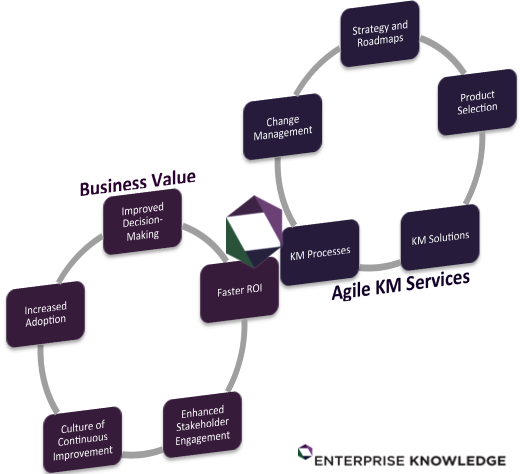Companies in nearly every industry are adopting Agile techniques to enhance IT projects, manage marketing initiatives, and manage their business. If you are passionate about Knowledge Management (KM), you may wonder how Agile and KM fit together. We at Enterprise Knowledge (EK) have always considered Agile a natural part of the KM process. Long before the term Agile was in vogue, we were using Agile principles to capture requirements and facilitate design efforts for knowledge and information management (KIM) systems. We continue to apply Agile to engagements to help our customers with:
- KM Strategy and Roadmap

- Product Selection;
- Implementation of KM Solutions;
- Implementing KM Processes; and
- Change Management.
Our KM Strategy engagements follow Agile concepts for the discovery and recommendation phases. Each engagement begins with a mission and vision statement. Think of this as the first iteration. In the second sprint we begin to divide the vision into distinct areas. With each successive sprint, we drill down into each distinct area to better understand our customer’s needs. This Agile discovery process allows us to quickly understand our client’s needs without losing site of their higher level goals. Once we understand our client’s needs, we iterate different solutions with the customer so that we can continually refine our recommendations as part of the final report. This iterative process allows us to identify issues up front, maintain close contact with the business users and core business value, and make sure that there are no surprises with the final recommendation.
Our product selection methodology is based on Agile best practices. We’ve previously discussed this methodology in our Agile Roadmaps for Product Selection blog post. As with our strategy engagements we use Agile Roadmapping techniques to define product needs at a high level. We identify the high level functional areas of the new system. Once these areas are agreed upon, we drill down into each area to understand in greater detail what is required. As we develop a solid understanding of what the new system needs to do, we can begin to identify candidate solutions. Product selection typically begins with a set of 5-7 scenarios that test common and important activities required by the new system. Candidate products are selected quickly, and each vendor works with our customer’s IT department to develop prototypes that test the system. This prototyping process allows everyone to see how each product works in their environment. The system that performs the best in the scenarios is the product that is selected.
As you would expect, EK consultants use Agile for the implementation of our clients systems as well. Agile processes allow project team to adjust to new requirements common in KM implementation. The hands-on nature of the iterations allow users to comment on what they see and not just the requirements written on paper. This approach also helps with adoption as business stakeholders and end users are seeing the new system early on in the process. It gives them time to think about how they would best use it and generates excitement for the eventual launch. We have used Agile to help with a wide range of KM implementations including:
- Content management systems,
- Collaboration tools,
- Web content management systems, and
- Search tools.
Implementing KM solutions with Agile greatly improves a project’s likelihood of success and our clients love the faster turnaround and hands-on nature inherent in the process.
Another area where we have had a lot of success applying Agile techniques is change management. All of our KM engagements involve some sort of change management. Both technology implementations and changes in business processes are tricky to implement and often fail to get fully adopted. EK uses an iterative approach to introducing changes that allows people to adjust to changes along the way. Each small change is measured against predetermined success metrics to make sure that our changes have an impact. Our customers like this approach because:
- They get a return on their KM investment sooner;
- Their users are not overwhelmed with change; and
- Our approach creates a culture of continuous improvement that continues after we finish our engagement.
Are you looking to improve the way people find and manage information in your organization? Do you want to do it in a less risky way that offers results sooner? Email us at info@enterprise-knowledge.com to learn more about how EK’s Agile Knowledge Management team can deliver practical solutions for knowledge and information management quickly.
